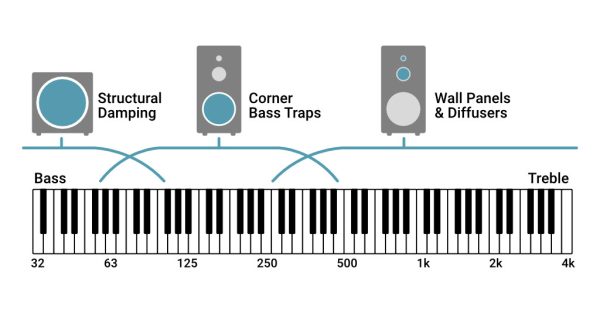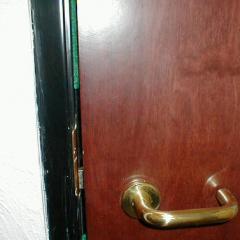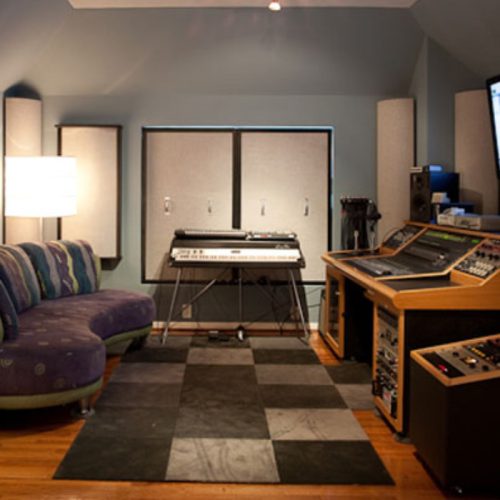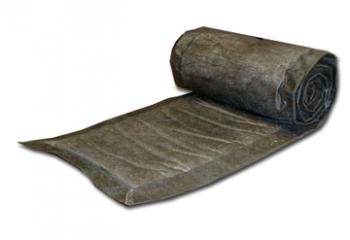ASC Soundproofing
Big speakers vibrate the listening room walls. The neighbors don’t want to hear it and neither do you. To be successful in soundproofing projects you have to address both parts of the soundproofing equation.
First part: Block the sound Second part: Absorb the sound (that you just blocked)
Most soundproofing projects and advice involve the blocking of sound. But when it really matters, you have to also absorb the sound you just blocked. When you just block the sound, what happens to it? It is reflected back where it came from. This is probably OK for residential and commercial soundproofing but it is specifically not OK when it comes to audio soundproofing. What is the difference? Bandwidth.
Residential and commercial sound sources are voices, and voices tend to be fairly weak in the deep bass range. Audio sound sources, typically subwoofers, are very powerful in the deep bass region. The difference between typical Residential/commercial Soundproofing and Audio Soundproofing is how the deep bass range of sound is handled.
Standard Residential/commercial Soundproofing standards are specified by the STC rating Sound Transmission Coefficients. which measures the soundproof quality of the wall in the voice range of sound 100 Hz thru 4,000 Hz, just over 5 octaves in the middle range of sound.
Audio Soundproofing performance is measures soundproof quality throughout the entire 10 octave range of sound 20 Hz to 20k Hz. The most difficult part of Audio Soundproofing involves Bass Range Soundproofing, the first 2 octaves of sound, 20 to 80 Hz. And that is our specialty, AudioRange soundproofing.
There are two conditions for soundproofing to work. Reflect and then Absorb the unwanted sound. In residential/commercial work the sound is reflected back into the room where it came from and absorbed by wall friction, carpets and sometimes acoustic ceiling tiles. In Audio Soundproofing the Bass Range of sound cannot be reflected back into the room, it has to be absorbed within the walls of the room.
Here is where the ASC WallDamp™ system of soundproofing is utilized. The exterior wall of the room blocks the deep bass while the flexible vibration damped interior wall of the room absorbs the deep bass.
Installed in hundreds of high end audio rooms, the result is the only soundproofing system engineered for high volume audio playback.
By utilizing our proprietary WallDamp material (a visco-elastic polymer) throughout the system, low frequency sound energy is absorbed into the wall. This reduces bass feedback and shuddering walls, and results in a clean, rich sound with well-balanced frequency response. If you have a home theater or studio, and you need to run cables through your soundproofed wall, consider the ASC Cable Pass Through Kit. The ASC Iso-Wall comes as a complete kit and is designed to be affordable and easy-to-install by any contractor or the do-it-yourself homeowner.
 In high power audio applications, the interior surface of the room can no longer be used as a sound proofing element. It is converted into an isolation wall that has damping added. It becomes a giant membrane bass trap for the subwoofer range of sound while continuing to load the woofer bass range of sound and softening major room modes.
In high power audio applications, the interior surface of the room can no longer be used as a sound proofing element. It is converted into an isolation wall that has damping added. It becomes a giant membrane bass trap for the subwoofer range of sound while continuing to load the woofer bass range of sound and softening major room modes.
The soundproofing component, if needed, is a specially constructed, bass proof wall located on the other side of the interior working wall. From simple soundproofing projects to complex professional sound conditioning/proofing projects, we continue to develop and provide the products, engineering services and project materials needed to get your job done right…right, the first time.
People who build high performance audio rooms — home theaters, audiophile listening rooms and recording studios — need to keep inside sounds from getting out and outside sounds from getting into their room. That type of work is called soundproofing. One of the most soundproof rooms is your local racquetball court. The walls are so hard and thick that the sound can’t get out of the room, and so, it stays in the room, which is why the room is so reverberant. It would be impossible to put a high power audio playback system in a racquetball court and get the room to ever sound right. On the other hand most ordinary rooms may not be very soundproof but they certainly sound better than a racquetball court.
The high performance audio room owner wants a room that both sounds great and is soundproof. We have been helping people build their audio playback rooms since 1988. We have to build a room within a room to get audio playback rooms to sound right. The inner room is flexible like most good sounding rooms while the outer room is rigid, heavy and strong so the bass cannot escape. In our work, soundproofing the outer walls is only half of the project, conditioning the interior walls, floor and ceiling of the room to address sound and vibration is also part of the project.
Our focus is not just on soundproofing rooms, a racquetball court can do that job along with most other soundproofing systems. We are dedicated to creating great sounding soundproof rooms. In fact, we pioneered the art and science of building small rooms that are to be used for high performance audio playback.











